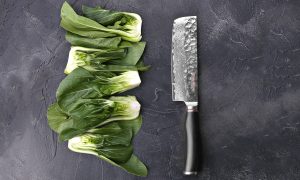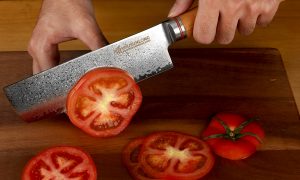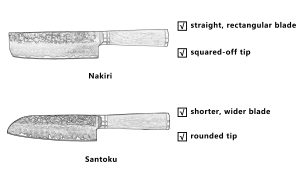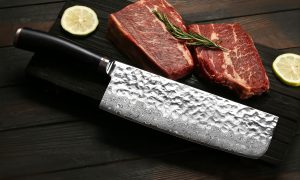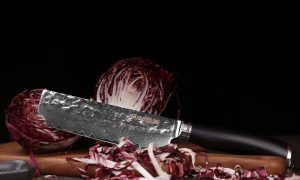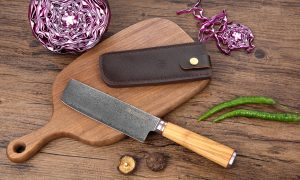1. Unveiling the Versatile Japanese Vegetable Knife
The Nakiri knife is a versatile and specialized kitchen tool that has gained popularity in both professional and home kitchens. Originating from Japan, this unique knife is specifically designed for slicing and chopping vegetables with precision and efficiency.
One defining feature of the Nakiri knife is its distinctive blade shape. Unlike a typical chef’s knife, the Nakiri knife features a straight, rectangular blade with a squared-off tip. This design allows for efficient vertical cuts, making it ideal for precise vegetable preparation.
The Nakiri knife boasts several key features that contribute to its exceptional performance. It typically has a thin, lightweight blade made from high-quality stainless steel or carbon steel. This construction ensures optimal sharpness, durability, and ease of maneuverability.
When it comes to practical uses, the Nakiri knife shines in vegetable-centric tasks. Its flat profile and razor-sharp edge make it perfect for slicing and dicing a variety of vegetables, including leafy greens, root vegetables, and delicate herbs. The straight blade guarantees even slices without crushing or tearing delicate ingredients.
Whether you’re a professional chef or an enthusiastic home cook, embracing the Nakiri knife in your kitchen arsenal will unlock new levels of culinary excellence and allow you to unleash your creativity in the realm of vegetable preparation.
2. Mastering the Art of Precise Vegetable Cutting
In the culinary world, precise vegetable cutting is an art form that distinguishes professional chefs from amateurs. The ability to execute clean and accurate cuts not only enhances the visual appeal of dishes but also ensures even cooking and optimal flavor distribution. To truly master this art, one must develop both skillful technique and a deep understanding of the tools involved.
First and foremost, grip the Nakiri knife with a firm hold, placing your thumb and index finger on either side of the blade’s base. This grip provides stability and control throughout the cutting process.
When using a Nakiri knife, employ a push-cutting motion. Start by placing the tip of the blade on the cutting board while ensuring the full length of the blade is in contact with the vegetable. Apply gentle downward pressure as you glide the blade forward, using a smooth and fluid motion to slice through the vegetable.
The straight, flat edge of the Nakiri knife excels at making precise vertical cuts. Whether you need thin slices, even dice, or fine julienne strips, the Nakiri’s design enables accurate and consistent results. Its rectangular shape allows for efficient slicing without rocking the blade, ensuring clean cuts without crushing or tearing delicate ingredients.
Take advantage of the Nakiri knife’s long blade length to guide your cuts with confidence. Use your non-dominant hand to secure the vegetable, curling your fingers inward and tucking them away from the blade’s path to ensure safety.
While the Nakiri knife shines in vegetable preparation, it’s essential to remember its limitations. Avoid using it for tasks such as deboning meat or cutting through tough-skinned produce, as its thin blade is not designed for these purposes.
With practice and familiarity, using a Nakiri knife will become second nature, allowing you to achieve precision and finesse in your vegetable cutting. Harness the exceptional capabilities of this knife to create beautifully presented dishes that showcase the artistry of your culinary skills.
3. Exploring the Distinct Differences Between Nakiri and Santoku
When it comes to choosing the right knife for your kitchen, understanding the differences between Nakiri and Santoku knives is essential. While both are popular Japanese-style knives, they have distinct features that set them apart.
The Nakiri knife, with its straight, rectangular blade, is specifically designed for vegetable preparation. Its flat edge allows for precise vertical cuts without the need for a rocking motion. This makes it ideal for slicing and dicing various vegetables with accuracy and uniformity. The Nakiri knife’s thin, lightweight blade ensures minimal resistance, promoting effortless cutting.
On the other hand, the Santoku knife features a shorter, wider blade with a slight curve. This versatile knife is an all-purpose workhorse, suitable for slicing, dicing, and mincing tasks. The curved belly of the Santoku facilitates a rocking motion, making it well-suited for chopping herbs and smaller ingredients. Its broader blade also provides more knuckle clearance, enabling efficient scooping and transferring of ingredients.
In terms of functionality, the Nakiri excels in precision vegetable cutting, while the Santoku offers versatility across a range of kitchen tasks.
Another difference lies in the blade tip. The Nakiri typically has a squared-off tip, offering stability during intricate vegetable cuts. In contrast, the Santoku features a rounded tip, allowing for easier maneuverability and reducing the risk of accidental punctures or injuries.
In summary, the Nakiri and Santoku knives have distinct differences that cater to different needs in the kitchen. The Nakiri excels in vegetable preparation, providing precise vertical cuts and efficient slicing. Meanwhile, the Santoku offers versatility across a range of tasks, with its ability to slice, dice, and mince various ingredients. Understanding these differences allows you to select the knife that aligns with your specific cooking style and preferences.
4. Key Factors to Consider in Your Shopping Nakiri Knives
When shopping for a Nakiri knife, several key factors should be taken into consideration to ensure you find the perfect knife for your needs. Let’s explore these factors in detail:
(1)Material
When selecting a Nakiri knife, pay attention to the blade material. For superior quality, look for Nakiri knives made from Japanese Damascus steel, known for its exceptional sharpness, durability, and corrosion resistance.
(2)Size
The size of the Nakiri knife should align with your specific needs and comfort. Generally, blade lengths range from 6 to 7 inches, but there are also larger or smaller options available. A longer blade can facilitate slicing larger vegetables, while a shorter blade offers more maneuverability for intricate cuts.
(3)Weight and balance
The weight and balance of a Nakiri knife impacts its handling and control. Look for a knife that feels comfortable in your hand and offers a good balance between the blade and handle. Some prefer a lighter knife for precise cuts, while others prefer a slightly heavier one for added stability.
(4)Grip Comfort
The grip comfort of a Nakiri knife is crucial for extended use and safety. Consider the handle design and material, ensuring it provides a secure and ergonomic grip. Choose a handle that suits your hand size and preference, whether it’s a traditional wooden handle or a modern synthetic material.
(5)Visual Design
While aesthetics may not affect the performance of a Nakiri knife, it’s worth considering a design that matches your personal style and kitchen decor. Whether you prefer a traditional Japanese aesthetic with a wooden handle and intricate patterns on the blade, or a more modern and minimalist look, there are various visually appealing options to choose from.
Ultimately, choosing the right Nakiri knife involves finding a balance between your budget, preferences, and the knife’s quality and performance. By considering these key factors, you can make an informed decision and find a Nakiri knife that enhances your culinary experience and lasts for years to come.
5. YOUSUNLONG Nakiri Knives Review
(1) Blade Quality
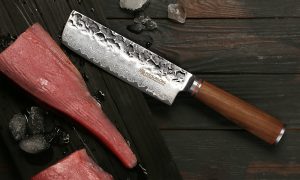
YOUSUNLONG Nakiri knives are crafted with precision and attention to detail, using hand-forged Damascus stainless steel blades. Each blade boasts a unique Damascus steel texture, achieved through the layering of 67 sheets of steel and a repeated folding method. This meticulous process ensures outstanding toughness and extreme hardness, with a remarkable HRC (hardness) rating of up to 60±.
(2) Razor-Sharp Edge
The YOUSUNLONG Nakiri knives feature a finely honed 15° angle V-shaped edge that guarantees exceptional sharpness. Cutting through ingredients feels effortless, akin to slicing through butter. The hand-hammered concave and convex pattern on the blade not only adds aesthetic appeal but also provides a superb anti-sticking effect. This maintains the original calcined effect and ensures smooth and easy cutting of meat and vegetables.
(3) Ergonomic Handle
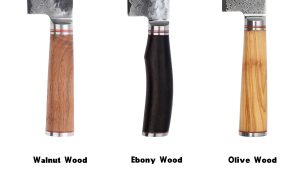
Designed for comfort and ease of use, the YOUSUNLONG Nakiri knives boast an ergonomic rounded shape handle. This thoughtfully crafted handle fits perfectly into the natural curve of your hand, allowing for effortless cutting motions. It provides balance, comfort, and leverage during use, enhancing overall control and precision. Made from 100% natural wood, the handle offers low moisture content, durability, and resistance to cracking or warping over time.
(4) Balance and Weight
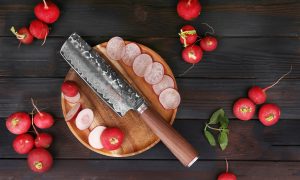
YOUSUNLONG Nakiri knives are meticulously balanced, allowing for comfortable handling and precise control. The pivot point, combined with the knife’s weight distribution, enables smooth rocking motions while maintaining optimal knife balance. This design feature is particularly useful for quick and continuous chopping motions, making your cutting tasks more efficient and enjoyable.
(5) Durability and Maintenance
With their forged Damascus stainless steel blades, YOUSUNLONG Nakiri knives are built to last. The high-quality materials used ensure exceptional durability, making these knives reliable companions in the kitchen for years to come. To further preserve their longevity, it is recommended to avoid cutting frozen foods, bones, or using excessive force. Additionally, twisting or prying food apart should be avoided as it can cause split cuts and potentially damage the blade.
(6) Affordability
Despite their outstanding quality and craftsmanship, YOUSUNLONG Nakiri knives offer affordability compared to other premium chef knives on the market. Each knife comes with a customized sheath made of highly flexible leather that is resistant to moisture. The knives are also presented in a beautiful premium gift box, making them an ideal choice for professional chefs or passionate home cooks seeking both performance and aesthetic appeal.
With proper care, these knives will be reliable partners in your culinary journey, enhancing your cooking experience with precision and style.
